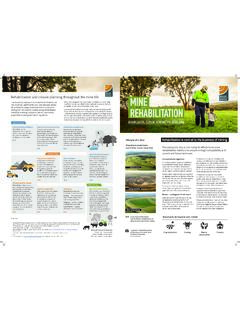Transcription of COMMODITY DEMAND Outlook - Minerals Council of Australia
1 Minerals Council OF Australia & COMMODITY INSIGHTSCOMMODITY DEMAND Outlook 2030As the world economy recovers from the impacts of the COVID-19 pandemic, the global trends that have driven growth in mineral and energy COMMODITY DEMAND through the last 20 years will not only continue, but accelerate. COMMODITY DEMAND Outlook 2030 outlines the long-term prospects for key mineral and energy commodities produced by Australia and how global trends will shape opportunities for the australian economy. It draws on analysis and forecasts from industry experts COMMODITY Insights, consultants commissioned by the report highlights how the technology-led productivity growth that has lifted the incomes and improved the living standards of millions of people in highly populated economies will be a driving force of higher COMMODITY consumption. Coupled with rising urbanisation rates, this will drive higher DEMAND for industrial commodities such as steel, zinc and copper to build high density housing, new manufacturing plants and connect cities with larger transport infrastructure networks.
2 As incomes rise, consumption of household electrical appliances, consumer electronics and packaged food in these economies will grow, supporting increased aluminium DEMAND . Ongoing innovation will see smaller, more powerful circuits and processors which rely on rare earth elements, copper and silver to enhance their transition to zero emissions energy will accelerate in the next decade. This too will rely on new metal-intensive electricity generation and transportation technologies such as renewable energy, nuclear power and electric vehicles that will create higher DEMAND for lithium, uranium, copper and nickel. The MCA supports the Paris Agreement and reaching global net zero as soon as possible through final trend that will continue shaping global financial systems is the growing reliance of governments on expansionary monetary policy and debt-financed public spending to drive economic growth.
3 Increases in money supply and low yields on bonds will continue to push investors towards alternative low-risk, physical assets such as gold and silver growth opportunities for AustraliaCOMMODITY DEMAND Outlook 2030 InsideINDUSTRIAL COMMODITIES6 Iron ore8 Metallurgical coal10 Aluminium12 COMMODITIES14 Copper16 Nickel18 Rare earth elements20 growth opportunities for AustraliaThe australian mining industry is a world leader in the exploration geoscience, processing technologies and environmental management systems needed to sustainably meet the world s growing mineral and energy COMMODITY needs over the next decade. The MCA and the Minerals industry are working with communities, stakeholders, investors and governments to maximise Australia s potential role in future supply chains and continue to deliver the investment, jobs and support for local businesses that benefit all Australians.
4 Tania ConstableChief Executive OfficerMinerals Council of AustraliaENERGY COMMODITIES22 Thermal coal24 METALS26 Gold28 VOLUMEA ustralia was the world s largest iron ore exporter in 2020.$7. 8bROYALTIESIron ore s contribution to state government revenue in 2020.$117bEXPORT REVENUEIron ore was Australia s largest source of export revenue in industry was a significant employer in regional Australia in 2020. 51 GtRESOURCESA ustralia has the world s largest economically demonstrated resource (EDR) of iron ore.$396mEXPLORATIONE xploration expenditure by the iron ore industry in 2020. Iron From houses to stadiums to skyscrapers, more than half of the world s steel is used in construction. Infrastructure Iron ore makes the steel used to build the roads, bridges and ports that keep the world IronManufacturing Steel is the backbone of manufacturing and it starts with the machinery on the factory Q1 Tower in Surfers Paradise stands metres tall and required more than 9300 tonnes of steel in its oreINDUSTRIAL COMMODITYO utlook to 2030 The stock of steel in these highly-populated developing nations remains less than half that of OECD economies and will grow substantially over the next decade as new high-density housing, transport infrastructure and manufacturing plants are built.
5 Ongoing growth in steel use is expected to support robust DEMAND for high-grade iron ore, such as mined ores in Australia , which requires less energy per unit of steel and produces fewer carbon Insights forecasts seaborne iron ore DEMAND to rise moderately to 2030, from 1504 Mt in 2019 to 1616 Mt in 2030. This represents overall growth of 8 per cent over the forecast period, or at a compound average growth rate (CAGR) of per cent per China, the world s largest steel producer and consumer, COMMODITY Insights forecasts DEMAND for high-grade seaborne iron ore to remain high, but ease slightly in the second half of the next decade due to greater utilisation of recycled steel. Steel production in India is forecast to continue rising to 2030. However, India is likely to mainly use its own domestic iron ore resources to support its steel industry . India s resources tend to be lower grade and steel mills may look to higher grade iron ore imports to improve their operating , South Korea and Taiwan are projected to remain key markets for seaborne iron ore, but lower steel production in these advanced economies is expected to result in reduced DEMAND for iron urbanisation rates in highly populated Asian economies and their continued industrial expansion will drive growing steel DEMAND to 2030 (and beyond).
6 Seaborne iron ore tradeCommodity Insights, Department of industry , Science, Energy and Resources1800160014001200100080060040020 002002 2006 2010 2014 2018 2022 f 2026 f 2030 fMtSTRONGWEAKSTEEL IS THE FOUNDATION OF 21ST CENTURY ECONOMIES5 RISK: Rising competition from prospective mines in Africa and South FOR Australia : Robust DEMAND for high-grade iron ore in Asia s steel Metallurgical CarbonRail lines Australia has 33,000 km of heavy rail and 291 km of light rail. To withstand the extreme conditions without cracking, tracks are made from quality carbon steel alloys and undergo very high heat energy Metallurgical coal makes the steel used to build and distribute low emissions green energy, such as solar, hydro and wind power. Shipping Cargo and cruise ships rely on the strength of steel. The hull alone can contain more than 50,000 tonnes of steel.
7 A single tonne of steel requires around 750 kg of metallurgical VOLUMEA ustralia was the world s largest metallurgical coal exporter in 2020.$27bEXPORT REVENUEA ustralia is the world s largest exporter of metallurgical thermal and metallurgical coal jobs in Australia in 2020. $ expenditure at coal projects across Australia in 2020.$289mEXPLORATIONE xploration expenditure by the coal industry in 2020. $5bCOAL ROYALTIESAll coal s contribution to state government revenue in coalCommodity Insights forecasts seaborne metallurgical coal DEMAND to rise steadily to 2030, from 295 Mt in 2019 to 365 Mt in 2030. This represents overall growth of 24 per cent over the forecast period, or a CAGR of 2 per cent per annum. This DEMAND will be partly offset by a shift towards greater use of scrap steel among OECD nations. DEMAND will primarily be driven by India and South East Asia, economies that not only have strong population growth but a rapidly growing appetite for steel in infrastructure, cars and consumer goods.
8 DEMAND for imported metallurgical coal in these markets will be high as their domestic coal resources are not suited to steel s seaborne imports will rise initially and then slowly decline due to the increased utilisation of scrap in the steel production process. Japan and South Korea are projected to remain key markets for metallurgical coal over the next 10 years, but with DEMAND declining in line with lower steel DEMAND will recover slowly from COVID-19 and declines in the traditional western European steel-producing nations will be offset by growth in Turkey, so overall DEMAND in 2030 will be in line with emission, or green steel, technologies are under development around the world. However COMMODITY Insights does not see this technological development as materially impacting metallurgical coal DEMAND for steel production during the forecast period.
9 Steel DEMAND in emerging economies is set to rise through new high density housing, transport infrastructure and industrial machinery. INDUSTRIAL COMMODITYSTRONGWEAK70% OF WORLD STEEL PRODUCTION RELIES ON COAL400350300250200150100500Mt2002 2006 2010 2014 2018 2022 f 2026 f 2030 fMetallurgical coal tradeCommodity Insights7 Outlook to 2030 RISK: Growing competition from new metallurgical coal mines in Russia and FOR Australia : Growing DEMAND for high-quality coal that reduces steel industry carbon $ REVENUEA luminium was Australia s 7th largest export in in Australia s aluminium industry in PRODUCTIONA ustralia is the world s 2nd largest producer of this intermediate product. 104 MtBAUXITE PRODUCTIONA ustralia s is the world s largest producer of this raw material. $2bWAGESA luminium industry wages are nearly triple the manufacturing average.
10 $5bLOCAL SPENDA nnual spend by the aluminium industry on local supply chains. 13Al AluminiumHousehold appliances Rust-resistant aluminium is used to make household goods, such as fridges and dishwashers. Infinitely recyclable, around 75 per cent of all aluminium ever produced is still in use cans Over two billion aluminium cans are recycled every year in Australia , but that still leaves 900 million cans that end up in landfill. The scrap metal value of those buried cans? $15 Roughly one-third the weight of steel, aluminium has been used in aviation since the Wright Brothers took flight in 1903. 8 AluminiumWorld consumption of aluminium has increased substantially over the last 20 years, underpinned by rapid DEMAND growth from higher incomes, rising urbanisation and greater car ownership in emerging economies in same trends will continue in the long-term and spur even higher aluminium consumption by 2030.





